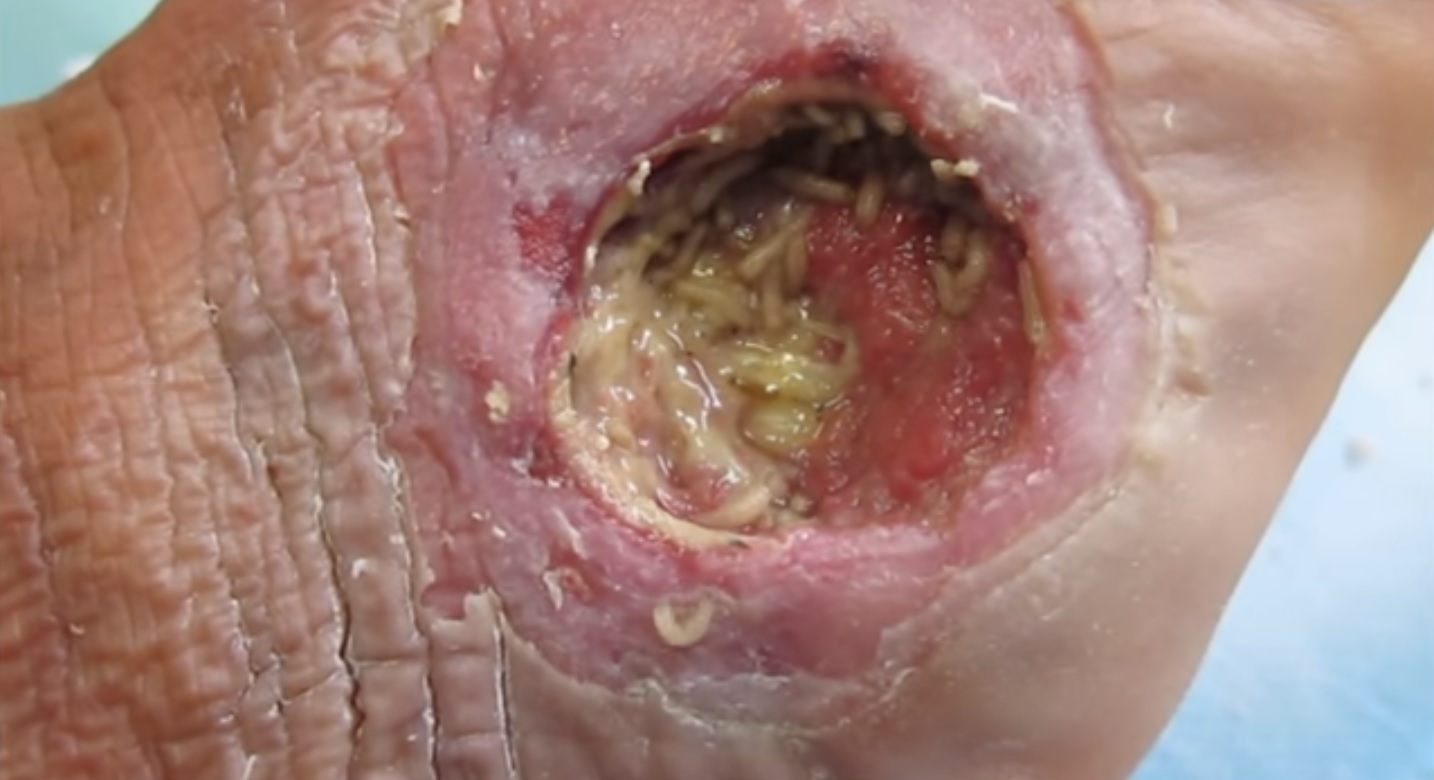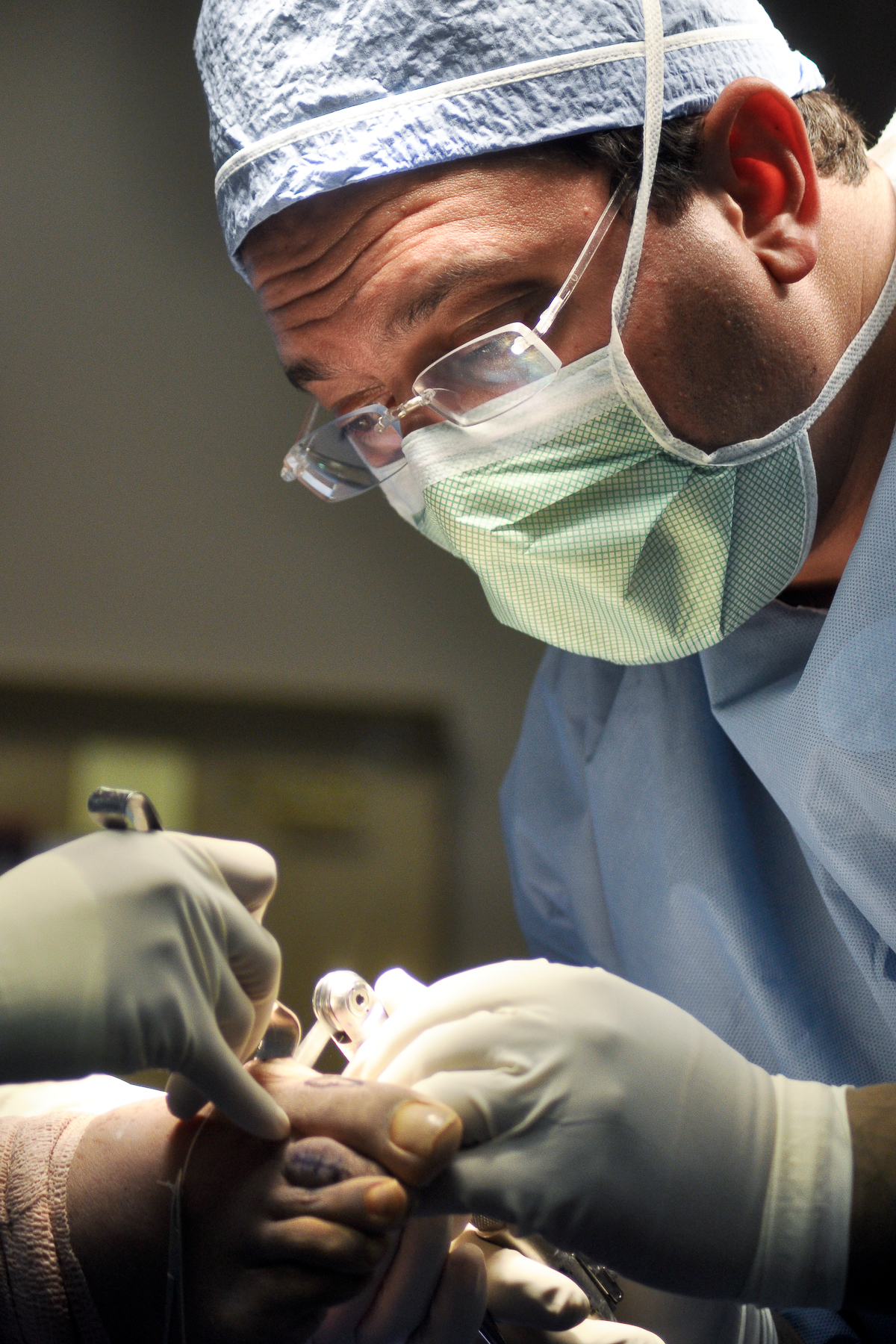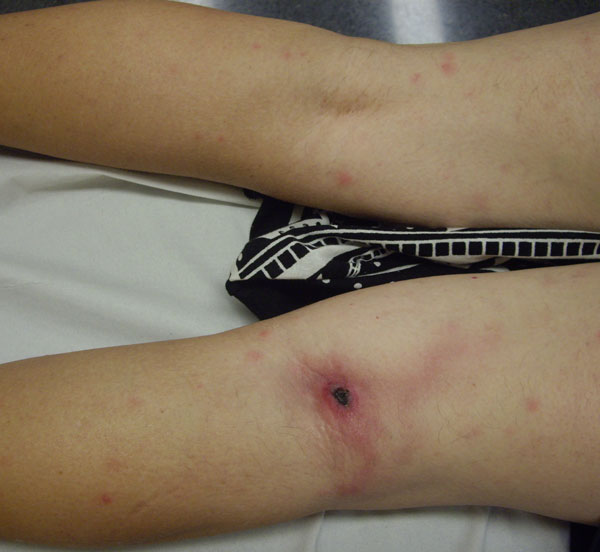|
Debride
Debridement is the medical removal of dead, damaged, or infected tissue to improve the healing potential of the remaining healthy tissue. Removal may be surgical, mechanical, chemical, autolytic (self-digestion), and by maggot therapy. In podiatry, practitioners such as chiropodists, podiatrists and foot health practitioners remove conditions such as calluses and verrucas. Debridement is an important part of the healing process for burns and other serious wounds; it is also used for treating some kinds of snake and spider bites. Sometimes the boundaries of the problem tissue may not be clearly defined. For example, when excising a tumor, there may be micrometastases along the edges of the tumor that are too small to be detected, but if not removed, could cause a relapse. In such circumstances, a surgeon may opt to debride a portion of the surrounding healthy tissue to ensure that the tumor is completely removed. Types There is lack of high quality evidence to compare th ... [...More Info...] [...Related Items...] OR: [Wikipedia] [Google] [Baidu] |
Maggot Therapy
Maggot therapy (also known as larval therapy) is a type of biotherapy involving the introduction of live, disinfected maggots (fly larvae) into non-healing skin and soft-tissue wounds of a human or other animal for the purpose of cleaning out the necrotic (dead) tissue within a wound, (debridement) and disinfection. There is evidence that maggot therapy may help with wound healing. Medical uses Maggot therapy improves healing in chronic ulcers. In diabetic foot ulcers there is tentative evidence of benefit. A Cochrane review of methods for the debridement of venous leg ulcers found maggot therapy to be broadly as effective as most other methods, but the study also noted that the quality of data was poor. In 2004, the United States Food and Drug Administration (FDA) cleared maggots from common green bottle fly for use as a "medical device" in the US for the purpose of treatment of: * Non-healing necrotic skin and soft tissue wounds * Pressure ulcers * Venous stasis ulcers * ... [...More Info...] [...Related Items...] OR: [Wikipedia] [Google] [Baidu] |
Necrotizing Fasciitis
Necrotizing fasciitis (NF), also known as flesh-eating disease, is a bacterial infection that results in the death of parts of the body's soft tissue. It is a severe disease of sudden onset that spreads rapidly. Symptoms usually include red or purple skin in the affected area, severe pain, fever, and vomiting. The most commonly affected areas are the limbs and perineum. Typically, the infection enters the body through a break in the skin such as a cut or burn. Risk factors include poor immune function such as from diabetes or cancer, obesity, alcoholism, intravenous drug use, and peripheral artery disease. It does not typically spread between people. The disease is classified into four types, depending on the infecting organism. Between 55 and 80% of cases involve more than one type of bacteria. Methicillin-resistant ''Staphylococcus aureus'' (MRSA) is involved in up to a third of cases. Medical imaging is often helpful to confirm the diagnosis. Necrotizing fasciitis may b ... [...More Info...] [...Related Items...] OR: [Wikipedia] [Google] [Baidu] |
Necrosis
Necrosis () is a form of cell injury which results in the premature death of cells in living tissue by autolysis. Necrosis is caused by factors external to the cell or tissue, such as infection, or trauma which result in the unregulated digestion of cell components. In contrast, apoptosis is a naturally occurring programmed and targeted cause of cellular death. While apoptosis often provides beneficial effects to the organism, necrosis is almost always detrimental and can be fatal. Cellular death due to necrosis does not follow the apoptotic signal transduction pathway, but rather various receptors are activated and result in the loss of cell membrane integrity and an uncontrolled release of products of cell death into the extracellular space. This initiates in the surrounding tissue an inflammatory response, which attracts leukocytes and nearby phagocytes which eliminate the dead cells by phagocytosis. However, microbial damaging substances released by leukocytes would crea ... [...More Info...] [...Related Items...] OR: [Wikipedia] [Google] [Baidu] |
Necrotic Tissue
Necrosis () is a form of cell injury which results in the premature death of cells in living tissue by autolysis. Necrosis is caused by factors external to the cell or tissue, such as infection, or trauma which result in the unregulated digestion of cell components. In contrast, apoptosis is a naturally occurring programmed and targeted cause of cellular death. While apoptosis often provides beneficial effects to the organism, necrosis is almost always detrimental and can be fatal. Cellular death due to necrosis does not follow the apoptotic signal transduction pathway, but rather various receptors are activated and result in the loss of cell membrane integrity and an uncontrolled release of products of cell death into the extracellular space. This initiates in the surrounding tissue an inflammatory response, which attracts leukocytes and nearby phagocytes which eliminate the dead cells by phagocytosis. However, microbial damaging substances released by leukocytes would creat ... [...More Info...] [...Related Items...] OR: [Wikipedia] [Google] [Baidu] |
Burn
A burn is an injury to skin, or other tissues, caused by heat, cold, electricity, chemicals, friction, or ultraviolet radiation (like sunburn). Most burns are due to heat from hot liquids (called scalding), solids, or fire. Burns occur mainly in the home or the workplace. In the home, risks are associated with domestic kitchens, including stoves, flames, and hot liquids. In the workplace, risks are associated with fire and chemical and electric burns. Alcoholism and smoking are other risk factors. Burns can also occur as a result of self-harm or violence between people (assault). Burns that affect only the superficial skin layers are known as superficial or first-degree burns. They appear red without blisters and pain typically lasts around three days. When the injury extends into some of the underlying skin layer, it is a partial-thickness or second-degree burn. Blisters are frequently present and they are often very painful. Healing can require up to eight weeks and scarri ... [...More Info...] [...Related Items...] OR: [Wikipedia] [Google] [Baidu] |
Autolysis (biology)
In biology, autolysis, more commonly known as self-digestion, refers to the destruction of a cell through the action of its own enzymes. It may also refer to the digestion of an enzyme by another molecule of the same enzyme. The term derives from the Greek αὐτο- ("self") and λύσις ("splitting"). Biochemical mechanisms of cell destruction Autolysis is uncommon in living adult organisms and usually occurs in necrotic tissue as enzymes act on components of the cell that would not normally serve as substrates. These enzymes are released due to the cessation of active processes in the cell that provide substrates in healthy, living tissue; autolysis in itself is not an active process. In other words, though autolysis resembles the active process of digestion of nutrients by live cells, the dead cells are not actively digesting themselves as is often claimed, and as the synonym self-digestion suggests. Failure of respiration and subsequent failure of oxidative phosphorylat ... [...More Info...] [...Related Items...] OR: [Wikipedia] [Google] [Baidu] |
Foot Health Practitioner
Podiatry () or podiatric medicine () is a branch of medicine devoted to the study, diagnosis, medical and surgical treatment of disorders of the foot, ankle, and leg. A Doctor of Podiatric Medicine (DPM), or a podiatrist, is a healthcare professional who diagnoses and treats conditions affecting the structures of the foot, ankle, and leg. The US podiatric medical school curriculum includes lower extremity anatomy, general human anatomy, physiology, general medicine, physical assessment, biochemistry, neurobiology, pathophysiology, genetics and embryology, microbiology, histology, pharmacology, women's health, physical rehabilitation, sports medicine, research, ethics and jurisprudence, biomechanics, general principles of orthopedic surgery, and foot and ankle surgery. Podiatry is a high-paying specialization and was listed by ''Forbes'' in 2007 as the 15th-best-paid profession in the United States. The median annual salary of a podiatrist in the US was $124,830 in 2016 acc ... [...More Info...] [...Related Items...] OR: [Wikipedia] [Google] [Baidu] |
Eschar
An eschar (; Greek: ''ἐσχάρᾱ'', ''eskhara''; Latin: ''eschara'') is a slough or piece of dead tissue that is cast off from the surface of the skin, particularly after a burn injury, but also seen in gangrene, ulcer, fungal infections, necrotizing spider bite wounds, tick bites associated with spotted fevers and exposure to cutaneous anthrax. The term ‘eschar’ is not interchangeable with ‘scab’. An eschar contains necrotic tissue whereas a scab is composed of dried blood and exudate. Black eschars are most frequently attributed in medicine to cutaneous anthrax (infection by '' Bacillus anthracis''), which may be contracted through herd animal exposure and also from ''Pasteurella multocida'' exposure in cats and rabbits. A newly identified human rickettsial infection, ''R. parkeri'' rickettsiosis, can be differentiated from Rocky Mountain spotted fever by the presence of an eschar at the site of inoculation. Eschar is sometimes called a ''black wound'' becau ... [...More Info...] [...Related Items...] OR: [Wikipedia] [Google] [Baidu] |
Papain
Papain, also known as papaya proteinase I, is a cysteine protease () enzyme present in papaya (''Carica papaya'') and mountain papaya (''Vasconcellea cundinamarcensis''). It is the namesake member of the papain-like protease family. It has wide ranging commercial applications in the leather, cosmetic, textiles, detergents, food and pharmaceutical industries. In the food industry, papain is used as an active ingredient in many commercial meat tenderizers. Papain family Papain belongs to a family of related proteins, known as the papain-like protease family, with a wide variety of activities, including endopeptidases, aminopeptidases, dipeptidyl peptidases and enzymes with both exo- and endopeptidase activity. Members of the papain family are widespread, found in Baculoviridae, baculoviruses, eubacteria, yeast, and practically all protozoa, plants and mammals. The proteins are typically lysosomal or secreted, and proteolytic cleavage of the propeptide is required for enzyme activa ... [...More Info...] [...Related Items...] OR: [Wikipedia] [Google] [Baidu] |
Bromelain
Bromelain is an enzyme extract derived from the stems of pineapples, although it exists in all parts of the fresh pineapple. The extract has a history of folk medicine use. As an ingredient, it is used in cosmetics, as a topical medication, and as a meat tenderizer. The term "bromelain" may refer to either of two protease enzymes extracted from the plants of the family Bromeliaceae, or it may refer to a combination of those enzymes along with other compounds produced in an extract. Bromelain enzymes are called ''fruit bromelain'' and ''stem bromelain''. Although tested in a variety of folk medicine and research models for its possible efficacy against diseases, bromelain has only one approved clinical application issued in 2012 by the European Medicines Agency a topical medication called ''NexoBrid'', used to remove dead tissue in severe skin burns. Extract components Bromelain extract is a mixture of protein-digesting (proteolytic) enzymes and several other substances in smal ... [...More Info...] [...Related Items...] OR: [Wikipedia] [Google] [Baidu] |
Chiropodists
Podiatry () or podiatric medicine () is a branch of medicine devoted to the study, diagnosis, medical and surgical treatment of disorders of the foot, ankle, and leg. A Doctor of Podiatric Medicine (DPM), or a podiatrist, is a healthcare professional who diagnoses and treats conditions affecting the structures of the foot, ankle, and leg. The US podiatric medical school curriculum includes lower extremity anatomy, general human anatomy, physiology, general medicine, physical assessment, biochemistry, neurobiology, pathophysiology, genetics and embryology, microbiology, histology, pharmacology, women's health, physical rehabilitation, sports medicine, research, ethics and jurisprudence, biomechanics, general principles of orthopedic surgery, and foot and ankle surgery. Podiatry is a high-paying specialization and was listed by ''Forbes'' in 2007 as the 15th-best-paid profession in the United States. The median annual salary of a podiatrist in the US was $124,830 in 2016 ac ... [...More Info...] [...Related Items...] OR: [Wikipedia] [Google] [Baidu] |
Podiatrists
A podiatrist ( ) is a medical professional devoted to the treatment of disorders of the foot, ankle, and related structures of the leg. The term originated in North America but has now become the accepted term in the English-speaking world for all practitioners of podiatric medicine. The word chiropodist was previously used in the United States, but it is now regarded as antiquated. In the United States, podiatrists are educated and licensed as Doctors of Podiatric Medicine (DPM). The preparatory education of most podiatric physicians — similar to the paths of traditional physicians ( MD or DO) — includes four years of undergraduate work, followed by four years in an accredited podiatric medical school, followed by a three- or four-year hospital-based residency. Optional one- to two-year fellowship in foot and ankle reconstruction, surgical limb salvage, sports medicine, plastic surgery, pediatric foot and ankle surgery, and wound care is also available. Podiatrists are li ... [...More Info...] [...Related Items...] OR: [Wikipedia] [Google] [Baidu] |









